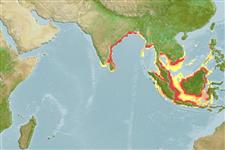>
Clupeiformes (Herrings) >
Pristigasteridae (Pristigasterids)
Etymology: Ilisha: An Indian name.
Eponymy: Pieter Nicolaas van Kampen (1878–1937) was a Dutch herpetologist and ichthyologist who was Professor of Zoology, Leiden University, until his retirement (1917–1931). [...] (Ref. 128868), visit book page.
More on authors: Weber & deBeaufort.
Environment: milieu / climate zone / depth range / distribution range
Ökologie
seewasser; süßwasser; brackwasser; amphidrom (Ref. 51243); tiefenbereich 0 - 50 m (Ref. 188). Tropical; 24°N - 9°S, 76°E - 121°E (Ref. 188)
Indo-Pacific: Indian Ocean (eastern coasts of India north to Calcutta), Indonesia (Jakarta, Java; also Kalimantan at Kotabaru, Takisung on southeastern coast and at Aluhaluh on Barito River). Records from the Arabian Sea and Thailand (Ref. 1632) need confirmation.
Size / Gewicht / Alter
Maturity: Lm ? range ? - ? cm
Max length : 15.0 cm SL Männchen/unbestimmt; (Ref. 188)
Rückenflossenstacheln (insgesamt) : 0; Afterflossenstacheln: 0; Afterflossenweichstrahlen: 38 - 46. Body moderately slender, belly with usually 19 to 21 - 8, total 27 to 29 scutes. Eye large, lower jaw projecting. Dorsal fin origin at about midpoint of body; anal fin origin under hind part of dorsal fin base. Vertical striae on scales not continuous, but with a distinct gap across center of scale. Swim bladder with two tubes passing back in the muscles on either side of haemal spines.
Occurs in coastal waters, but also enters rivers and tolerates water of low salinity. Feeds on planktonic crustaceans and fishes; also amphipods.
Life cycle and mating behavior
Geschlechtsreife | Fortpflanzung | Ablaichen | Eier | Fecundity | Larven
Whitehead, P.J.P., 1985. FAO Species Catalogue. Vol. 7. Clupeoid fishes of the world (suborder Clupeoidei). An annotated and illustrated catalogue of the herrings, sardines, pilchards, sprats, shads, anchovies and wolf-herrings. FAO Fish. Synop. 125(7/1):1-303. Rome: FAO. (Ref. 188)
IUCN Rote Liste Status (Ref. 130435: Version 2024-1)
Bedrohung für Menschen
Harmless
Nutzung durch Menschen
Fischereien: weniger kommerziell
Tools
Zusatzinformationen
Download XML
Internet Quellen
Estimates based on models
Preferred temperature (Ref.
123201): 27.7 - 29.3, mean 28.8 °C (based on 590 cells).
Phylogenetic diversity index (Ref.
82804): PD
50 = 0.5000 [Uniqueness, from 0.5 = low to 2.0 = high].
Bayesian length-weight: a=0.00891 (0.00401 - 0.01981), b=3.04 (2.87 - 3.21), in cm total length, based on LWR estimates for this Genus-body shape (Ref.
93245).
Trophic level (Ref.
69278): 3.3 ±0.36 se; based on food items.
Widerstandsfähigkeit (Ref.
120179): hoch, Verdopplung der Population dauert weniger als 15 Monate. (Preliminary K or Fecundity.).
Fishing Vulnerability (Ref.
59153): Low vulnerability (10 of 100).
